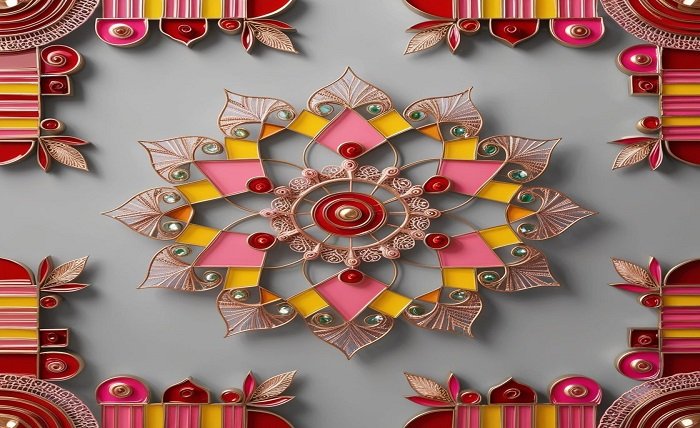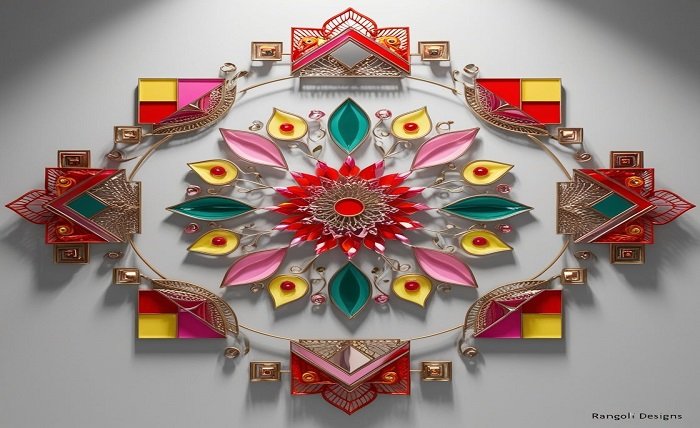Indian simple 3d rangoli designs are traditional works of art that are used to decorate homes for festivals, marriages, and other special events. Traditionally made using rice, flower petals, or colorful powders, these elaborate patterns stand for prosperity, good fortune, and welcome. Simple 3D rangoli designs offer a distinctive touch that gives this beloved art form more depth and dimension, even though classic rangoli is unquestionably lovely. We will examine several facets of basic 3D rangoli designs in this blog article, offering ideas and detailed instructions for making your own.
Rangoli: What is it?
Rangoli is a type of ornamental art in which different materials are used to create patterns on the ground. Simple geometric shapes to intricate motifs showing gods, the natural world, and cultural icons can be found in the designs. Although colored powders are traditionally used to make rangoli, more contemporary designs may incorporate sand, flowers, or even leaves.
Rangolis have several uses: they greet guests, improve the aesthetic appeal of homes, and are thought to bring good fortune. Rangoli, which displays creative ingenuity and cultural history, becomes an integral element of the celebrations during holidays like Diwali, Pongal, and Onam.
Rangoli’s Development: From Traditional to 3D
Although rangoli designs are traditionally flat, this art form’s growth has given rise to creative methods, such as 3D designs. By adding shadows, layers, and various textures, simple 3d rangoli designs elevates the art to a new level and produces a visual experience that seems to jump off the page.
Essential Elements of 3D Rangoli
Depth and Size: simple 3d rangoli designs are visually striking because they give the impression of depth.
Use of Shadows: To enhance the 3D illusion, strategically place colors and materials to cast shadows.
Layering Techniques: Layers that increase the intricacy of the design can be created by combining various materials and colors.
Textured Materials: To add even more character to the design, try including materials with texture, such as lentils, rice, or beads.
Essential Supplies Required for 3D Rangoli

The materials needed to create basic simple 3d rangoli designs are modest, making this art form accessible to everyone who wants to give it a try. A list of typical supplies you’ll need is provided below:
Colored powders: You can make these with store-bought rangoli powders, rice flour, or chalk powder.
Flower Petals: You may add texture and color with either fresh or dried flower petals.
Grains: You can make layers using rice, pulses, and other grains.
Using stencils: optional but useful for getting exact patterns and shapes.
Water: To set the powders in place, a tiny bit of water can be used.
Easy 3D Rangoli Designs You Should Try
These are six easy-to-make, gorgeous simple 3d rangoli designs that you may make at home. Every design is simple to use and ideal for novices.
Three-dimensional floral design
Materials: Tiny stones, colored powders, and petals from flowers.
Actions:
- Select a striking range of colors for your flowers.
- Using colored powders, begin by sketching the outline of a huge flower in the middle of your desk.
- Using several tones, fill in the petals to get a gradient effect.
- Create an elevated impression around the petals by using flower petals.
- To improve the 3D appearance, add tiny stones or beads to the center.
Spiral Geometry
Ingredients: Rice, colored powders, and a tiny container.
Actions:
- Start by choosing a vibrant color to create a spiral shape in the center.
- To add contrast, fill the spiral with alternating colors.
- To produce a tiered look, sprinkle rice over the spiral’s outside borders using a tiny container.
- To clarify the design, finish by drawing a darker tint around the spiral.
Diya Setup
Materials: Flower petals, colored powders, and diyas (oil lamps).
Actions:
- Make a circle with the diyas, leaving room in between.
- Use colored powders to cover the empty spots to make a striking background.
- Create an elevated border by encircling the diyas with flower petals.
- Lighting the diyas is an optional way to improve the overall impression, particularly at night.
Some Ideas for Making Eye-Catching 3D Rangoli
Select an Appropriate Surface: A smooth, even surface will make your design pop.
Play Around with Colors: To provide depth and contrast, use complementary colors.
Develop Patience: Take your time creating the design; hurrying can result in errors.
Include Natural Elements: You can improve the rangoli’s aesthetic appeal by using flower petals or leaves.
Use Light: If you’re using 3D effects in your design, pay close attention to how lighting will impact it.
Summary
Uncomplicated simple 3d rangoli designs patterns provide a cherished custom a new outlook. Your festive celebrations will be enhanced by the eye-catching patterns you may create with layers, shadows, and textures. Whether you’re getting ready for Pongal, Diwali, or any other special occasion, playing around with 3D rangoli may be a fun and rewarding creative endeavor.
FAQs
Q1: Can I create simple 3d rangoli designs with materials other than colored powders?
Indeed! To create textured designs, you can use grains, pearls, or even petals from flowers.
Q2: What is the lifespan of a simple 3d rangoli designs?
A rangoli design’s durability is influenced by the materials chosen and the surrounding circumstances. Designs that are indoors might endure longer than those that are outside.
Q3: Is designing simple 3d rangoli designs patterns challenging?
Not at all! Many of the designs are easy enough for beginners to use. You can learn increasingly complicated patterns with practice.
Q4: Is it possible to reuse materials for rangoli?
Sure, you can reuse a lot of materials like beads or grains, but you might need to replace the petals of flowers for every design.
Q5: After making a rangoli, how should I clean up?
To get rid of the materials, give the area a gentle sweep or vacuum. Composting natural ingredients is an environmentally responsible way to use them.
Read more about: On cloud shoes

